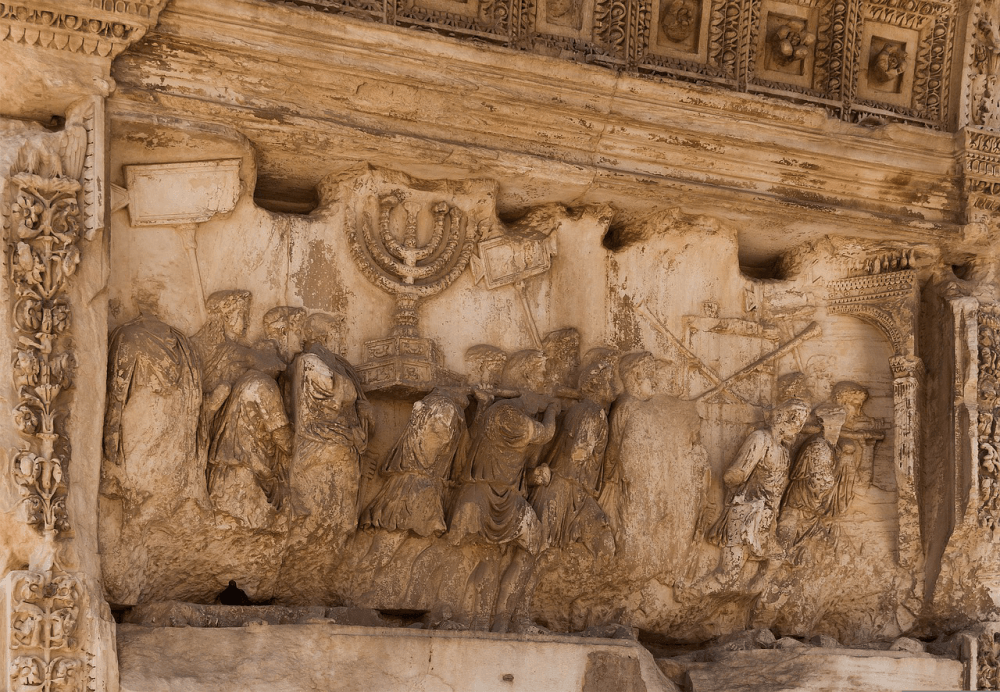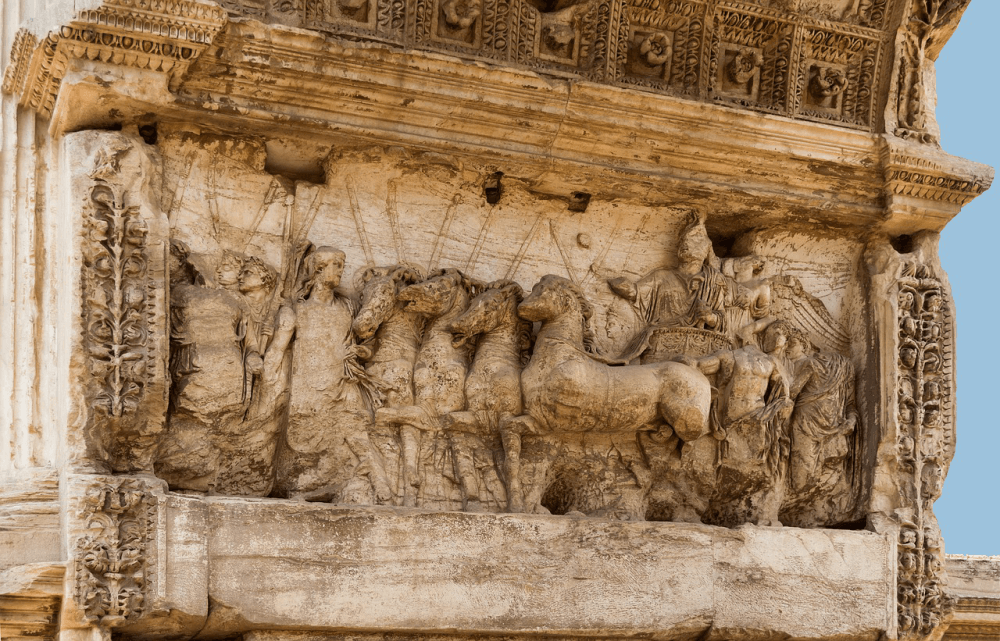What is The Arch of Titus?

The Arch of Titus (Latin: Arcus Titi) is a triumphal arch in Rome, located on the Via Sacra, a street that runs in a straight line between the Roman Forum and the Colosseum. This was one of the main thoroughfares of the ancient city of Rome, meaning that the arch was built in a prominent position within the city.
It has a single arched opening and the entire structure is 15.4m high, 13.5m wide, and 4.75m deep.
It was erected in honor of Titus Flavius Vespasianus, better known later as Emperor Titus, following his death in 81 AD. The arch commemorates his military victories in The Jewish War (also known as The Great Jewish Revolt or the Jewish-Roman War) in the Roman province of Judaea; most notably the Siege of Jerusalem eleven years earlier in 70 AD. This was before he became emperor; Titus was made responsible for suppressing Jewish revolt while his father, the emperor Vespasian, dealt with matters during the Roman Civil War of 69 AD.
The Construction of the Arch of Titus
The arch was built after Titus' death, during the reign of his brother, Emperor Domitian. The exact year of construction is not known, but it was certainly round about the year 81 AD.
The arch was constructed using white marble from the nearby quarries of Carrara and Luna, and is decorated with reliefs depicting scenes from the siege. The main events that are also commemorated are the looting of the Jewish temple, and the later triumphal procession, in which Titus rode through Rome in a chariot carrying loot and captives from Jerusalem.
The Reliefs on the Arch of Titus

In 2012 the Arch of Titus Digital Restoration Project discovered remains of yellow ochre paint, which is evidence that the reliefs on the Arch of Titus were originally brightly colored, but today the color has been lost due to centuries of exposure to the elements.
As mentioned above, they depict the Roman sack of Jerusalem and the subsequent looting of the Temple and bearing away the spoils of war. They also depict Titus being crowned by the goddess Victory, symbolizing the successful conclusion of the siege.
The main relief on the arch depicts Titus as he returns from Jerusalem with his spoils of war, including the Menorah (seven-branched candelabrum), which was taken from the Temple. The depiction is an important record of Roman military victory, as well as a reminder of Rome's power over Judaea.
These reliefs are some of the only surviving depictions of the Roman sacking of Jerusalem, and give us a vivid picture of the destruction that took place during this time. The images on the arch would have been seen as propaganda by contemporary viewers, meant to celebrate Rome's military might and further legitimize their rule over the province of Judaea.
What Happened in Judaea? - The Fall of Jerusalem and the Destruction of the Second Temple
The province of Judaea had been a difficult situation for the Romans for many years. Located between the wealthy Roman provinces of Egypt and Syria, it was of strategic importance. However, many of the inhabitants of Judaea despised Roman rule and the occupation of their territory.
Revolt finally broke out in 66 AD, and despite some early successes, and the Romans themselves being somewhat distracted by the Civil War and Year of the Four Emperors in 69 AD, the Romans slowly began to put down more and more pockets of rebellion.
On August 15th in the year 70 AD, Roman legions under the command of Titus sacked and burned Jerusalem. The Second Temple, which had stood for over 500 years, was destroyed. This event marks the end of Jewish autonomy in Judaea and the beginning of the Jewish diaspora (disbursement and settlement in other parts of the world).
The destruction of the Second Temple was a crushing blow to the Jewish people. Not only was their place of worship destroyed, but also the seat of their political and religious power. The loss of Jerusalem and the Temple meant that Jews were now completed subjected to Roman rule.
The fall of Jerusalem and the destruction of the Second Temple had a profound impact on Judaism. It led to changes in religious practices and beliefs, as well as the development of new schools of thought. The rabbinic tradition emerged in response to these events, and it continues to shape Judaism to this day.
The Legacy of the Arch of Titus

The Arch of Titus has been studied by archaeologists and historians for centuries. It still stands to this day, and it continues to be one of the most popular tourist attractions in the modern-day city of Rome, Italy. It is a reminder of both the Roman Empire's former might, and its eventual fall.
The Arch of Titus is an important historical monument, and these reliefs help to tell the story of one of Rome's most significant military victories. The Arch of Titus is a symbol of the triumphalism, and destructive power, that characterized the Roman Empire.



Legions of Rome: The Definitive History of Every Imperial Roman Legion
by Stephen Dando-Collins
Featuring more than 150 maps, photographs, diagrams and battle plans, Legions of Rome is an essential read for ancient history enthusiasts, military history experts and general readers alike.